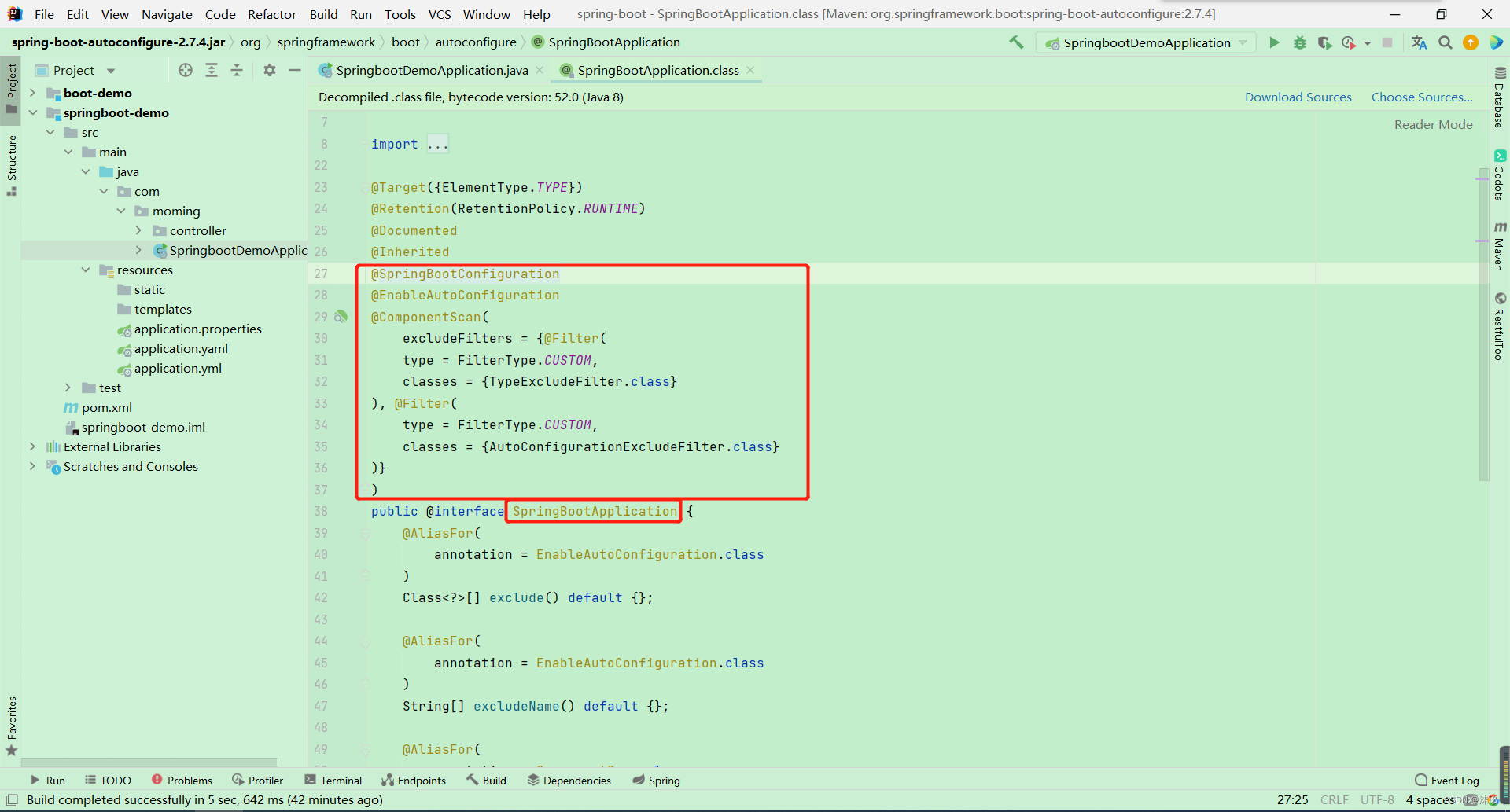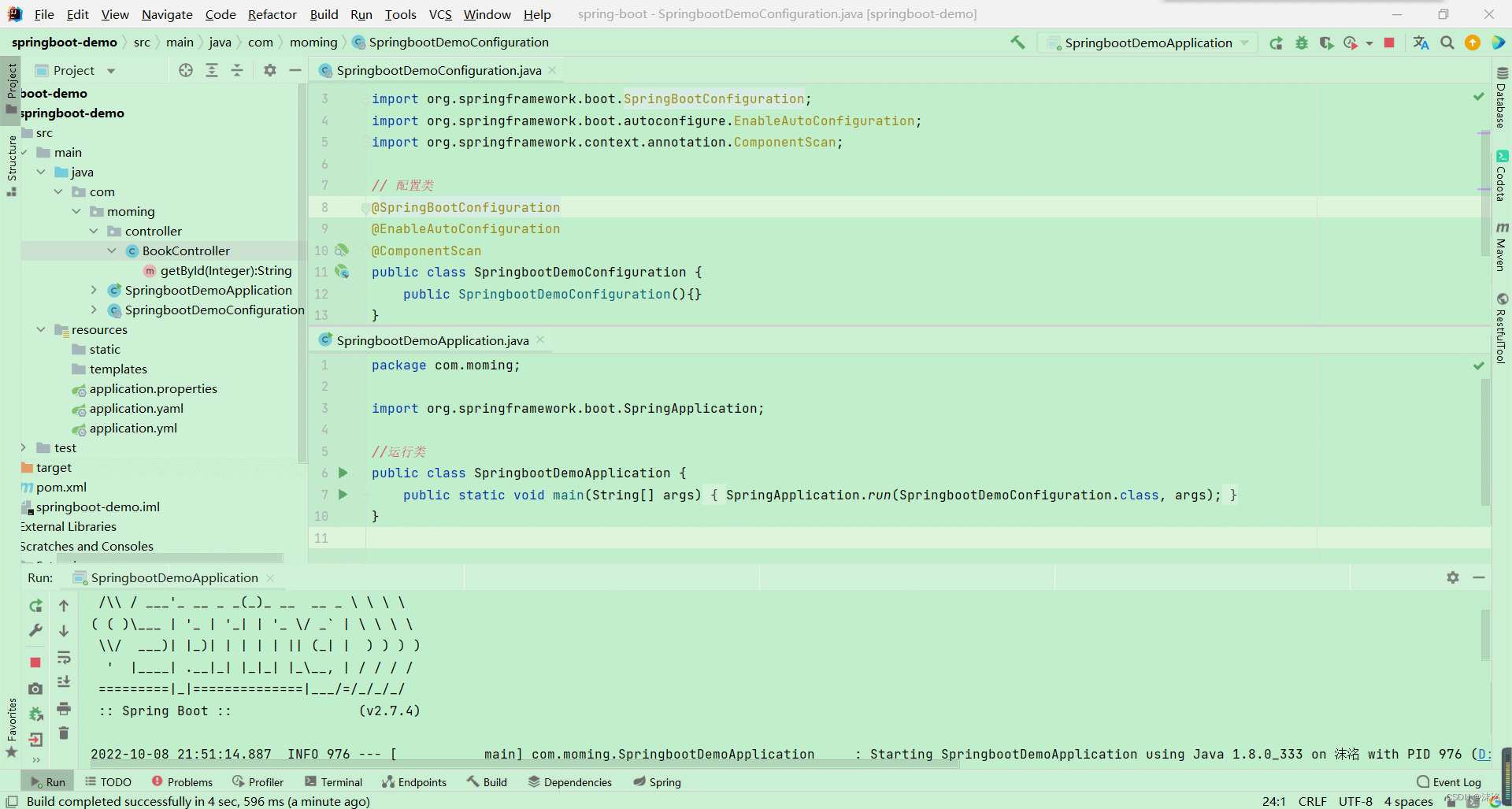SpringBoot Application核心注解详解
沫洺 人气:0@SpringBootApplication
@SpringBootApplication 是一个“三体”结构,实际上它是一个复合 Annotation:

@Target({ElementType.TYPE})
@Retention(RetentionPolicy.RUNTIME)
@Documented
@Inherited
@SpringBootConfiguration
@EnableAutoConfiguration
@ComponentScan(
excludeFilters = {@Filter(
type = FilterType.CUSTOM,
classes = {TypeExcludeFilter.class}
), @Filter(
type = FilterType.CUSTOM,
classes = {AutoConfigurationExcludeFilter.class}
)}
)虽然它的定义使用了多个 Annotation 进行元信息标注,但实际上对于 SpringBoot 应用来说,重要的只有三个 Annotation,而“三体”结构实际上指的就是这三个 Annotation:
- @SpringBootConfiguration
- @EnableAutoConfiguration
- @ComponentScan
所以,如果我们使用如下的 SpringBoot 启动类,整个 SpringBoot 应用依然可以与之前的启动类功能对等:
//@SpringBootApplication
@SpringBootConfiguration
@EnableAutoConfiguration
@ComponentScan
public class SpringbootDemoApplication {
public static void main(String[] args) {
SpringApplication.run(SpringbootDemoApplication.class, args);
}
}但每次都写三个 Annotation 显然过于繁琐,所以写一个 @SpringBootApplication 这样的一站式复合 Annotation 显然更方便些。
@SpringBootConfiguration
@Target({ElementType.TYPE})
@Retention(RetentionPolicy.RUNTIME)
@Documented
@Configuration
@Indexed
public @interface SpringBootConfiguration {
@AliasFor(
annotation = Configuration.class
)
boolean proxyBeanMethods() default true;
}这里的 @Configuration 对我们来说并不陌生,它就是 JavaConfig 形式的 Spring IoC 容器的配置类使用的那个 @Configuration,既然 SpringBoot 应用骨子里就是一个 Spring 应用,那么,自然也需要加载某个 IoC 容器的配置,而 SpringBoot 社区推荐使用基于 JavaConfig 的配置形式,所以,很明显,这里的启动类标注了 @SpringBootConfiguration 之后,本身其实也是一个 IoC 容器的配置类!很多 SpringBoot 的代码示例都喜欢在启动类上直接标注 @SpringBootConfiguration或者 @SpringBootApplication,对于初接触 SpringBoot 的开发者来说,其实这种做法不便于理解,如果我们将上面的 SpringBoot 启动类拆分为两个独立的 Java 类,整个形势就明朗了:
// 配置类
@SpringBootConfiguration
@EnableAutoConfiguration
@ComponentScan
public class SpringbootDemoConfiguration {
public SpringbootDemoConfiguration(){}
}//运行类
public class SpringbootDemoApplication {
public static void main(String[] args) {
SpringApplication.run(SpringbootDemoConfiguration.class, args);
}
}
所以,启动类 SpringbootDemoApplication其实就是一个标准的 Standalone(单独) 类型 Java 程序的 main 函数启动类,没有什么特殊的。而 @SpringBootConfiguration标注的 SpringbootDemoConfiguration 定义其实也是一个普通的 JavaConfig 形式的 IoC 容器配置类。
@EnableAutoConfiguration
是借助 @Import 的帮助,将所有符合自动配置条件的 bean 定义加载到 IoC 容器,仅此而已!
@EnableAutoConfiguration 作为一个复合 Annotation,其自身定义关键信息如下:
@Target({ElementType.TYPE})
@Retention(RetentionPolicy.RUNTIME)
@Documented
@Inherited
@AutoConfigurationPackage
@Import({AutoConfigurationImportSelector.class})
public @interface EnableAutoConfiguration {
String ENABLED_OVERRIDE_PROPERTY = "spring.boot.enableautoconfiguration";
Class<?>[] exclude() default {};
String[] excludeName() default {};
}其中,最关键的要属 @Import(AutoConfigurationImportSelector.class}),借助 AutoConfigurationImportSelector,@EnableAutoConfiguration 可以帮助 SpringBoot 应用将所有符合条件的 @SpringBootConfiguration配置都加载到当前 SpringBoot 创建并使用的 IoC 容器.
借助于 Spring 框架原有的一个工具类:SpringFactoriesLoader 的支持,@EnableAutoConfiguration 可以“智能”地自动配置功效才得以大功告成
@ComponentScan
@ComponentScan 是可有可无的
因为原则上来说,作为 Spring 框架里的“老一辈”,@ComponentScan 的功能其实就是自动扫描并加载符合条件的组件或 bean 定义,最终将这些 bean 定义加载到容器中。加载 bean 定义到 Spring 的 IoC 容器,我们可以手工单个注册,不一定非要通过批量的自动扫描完成,所以说 @ComponentScan 是可有可无的。
对于 SpringBoot 应用来说,同样如此,比如启动类:
@SpringBootConfiguration
@EnableAutoConfiguration
@ComponentScan
public class SpringbootDemoApplication {
public static void main(String[] args) {
SpringApplication.run(SpringbootDemoApplication.class, args);
}
}如果我们当前应用没有任何 bean 定义需要通过 @ComponentScan 加载到当前 SpringBoot 应用对应使用的 IoC 容器,那么,除去 @ComponentScan 的声明,当前 SpringBoot 应用依然可以照常运行,功能对等
加载全部内容